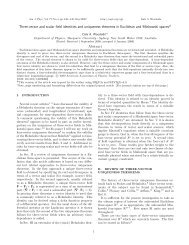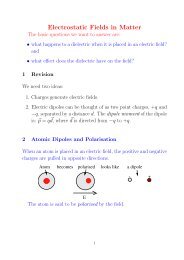Chapter 8 Vector Spaces in Quantum Mechanics
Chapter 8 Vector Spaces in Quantum Mechanics
Chapter 8 Vector Spaces in Quantum Mechanics
You also want an ePaper? Increase the reach of your titles
YUMPU automatically turns print PDFs into web optimized ePapers that Google loves.
<strong>Chapter</strong> 8 <strong>Vector</strong> <strong>Spaces</strong> <strong>in</strong> <strong>Quantum</strong> <strong>Mechanics</strong> 108made, as it is <strong>in</strong> classical physics, that such <strong>in</strong>fluences are sufficiently weak that they canbe ignored to a good approximation. In effect, we are suppos<strong>in</strong>g that the systems underconsideration are isolated systems, that is, systems that are isolated from the effect of anyexternal perturbations.Classically, at the macroscopic level, we can usually cont<strong>in</strong>ue to ignore weak perturb<strong>in</strong>g<strong>in</strong>fluences when specify<strong>in</strong>g the state of a system. In fact, when def<strong>in</strong><strong>in</strong>g a ‘system’ wetypically <strong>in</strong>clude <strong>in</strong> what we refer to as the ‘system’, all the participants <strong>in</strong> the physicalprocess be<strong>in</strong>g described that <strong>in</strong>teract strongly with each other. Anyth<strong>in</strong>g else that weaklyaffects these constitutents is ignored. For <strong>in</strong>stance, when describ<strong>in</strong>g the orbital dynamicsof the Earth as it revolves around the Sun, we might need to take <strong>in</strong>to account the gravitationalpull of the Moon – the system is the Earth, the Sun and the Moon. But we donot really need to take <strong>in</strong>to account the effect of the background microwave radiation leftover after the Big Bang. Or, when describ<strong>in</strong>g the collision between two billiard balls, itis probably necessary to <strong>in</strong>clude the effect of roll<strong>in</strong>g friction, but it not really necessaryto take <strong>in</strong>to account the frictional drag due to air resistance. Of course, sometimes it isnecessary to <strong>in</strong>clude external <strong>in</strong>fluences even when weak: to describe a system com<strong>in</strong>g tothermal equilibrium with its surround<strong>in</strong>gs it is necessary to extend the system by <strong>in</strong>clud<strong>in</strong>gthe environment <strong>in</strong> the dynamical model. In any of these examples, the same classicalphysics methods and philosophy applies.There is a subtle difference when it comes to try<strong>in</strong>g to apply the quantum ideas developedso far to macroscopic systems. The same, weak perturbations that can be put to one side<strong>in</strong> a classical description of a macroscopic system turn out to have a far-reach<strong>in</strong>g effect if<strong>in</strong>cluded <strong>in</strong> a quantum description of the same system. If we were to attempt to describe amacroscopic system accord<strong>in</strong>g to the laws of quantum mechanics, we would f<strong>in</strong>d that anyl<strong>in</strong>ear superposition of different possible states of the system evolves on a fantasticallyshort time scale to a classical mixture of the different possibilities. For <strong>in</strong>stance, if wewere to attempt to describe the state of a set of car keys <strong>in</strong> terms of two possibilities: <strong>in</strong>your pocket |p〉 or <strong>in</strong> your brief case |b〉, then a state of the form|ψ〉 = 1 √2( |p〉 + |b〉)(8.99)could be used to represent a possible ‘quantum state’ of the keys. But this quantum statewould be exceed<strong>in</strong>gly short lived (on a time scale ∼ 10 −40 sec), and would evolve <strong>in</strong>to thetwo alternative possibilities: a 50% chance of the keys be<strong>in</strong>g <strong>in</strong> the state |p〉, i.e. a 50%chance of f<strong>in</strong>d<strong>in</strong>g your keys <strong>in</strong> your pocket, and a 50% chance of be<strong>in</strong>g <strong>in</strong> the state |b〉,i.e. a 50% chance of f<strong>in</strong>d<strong>in</strong>g them <strong>in</strong> your brief case. But this is no longer a superpositionof these two states. Instead, the keys are either <strong>in</strong> the state |p〉 or the state |b〉. Whatthis effectively means is that randomness is still there, i.e. repeat<strong>in</strong>g an experiment underidentical conditions can give randomly vary<strong>in</strong>g results. But the state of the keys is nolonger represented by a state vector, so there are no longer any quantum <strong>in</strong>terferenceeffects present. The randomness can then be looked upon as be<strong>in</strong>g totally classical <strong>in</strong>nature, i.e. as be<strong>in</strong>g due to our ignorance of <strong>in</strong>formation that is <strong>in</strong> pr<strong>in</strong>ciple there, butimpossibly difficult to access. In effect, the quantum system behaves like a noisy classicalsystem.The process that washes out the purely quantum effects is known as decoherence. S<strong>in</strong>ceit is effectively impossible to isolate any macroscopic system from the <strong>in</strong>fluence of its
















